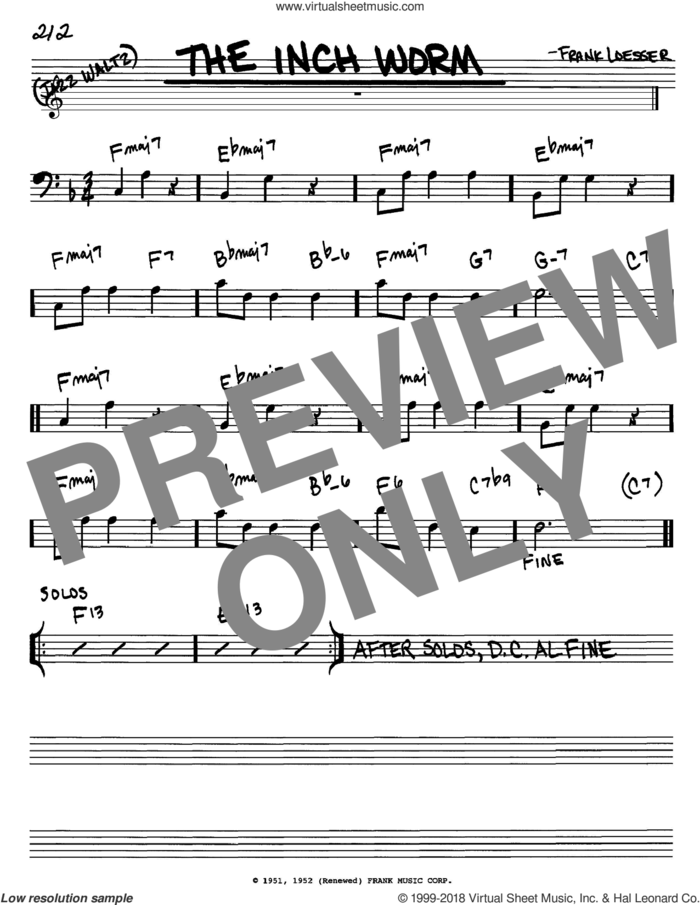

Loesser loved the intellectual challenge of such contrapuntal composition, which he also did in other works such as Tallahassee. In the film, a children's chorus sings the contrapuntal "arithmetic" section over and over inside a small classroom, dolefully and by rote, while Andersen, listening just outside, gazes at an inchworm crawling on the flowers and sings the main section of the song. Two and two are four Four and four are eight Eight and eight are sixteen Sixteen and sixteen are thirty-two Loesser wrote a counterpoint chorus that, sung by itself, has become popular as a children's song because of its arithmetical chorus: Subsequent verses include the lines "Measuring the marigolds, you and your arithmetic / You’ll probably go far" and "Seems to me you’d stop and see / How beautiful they are" Two and two are four Four and four are eight That’s all you have on your business-like mind Two and two are four Four and four are eight How can you be so blind?


The music has never sounded as bright and clean as it does here and in light of that advancement, it seems as if any arguable transgressions can be readily forgiven.The song's lyrics express a carpe diem sentiment, with the singer noting that the inchworm of the title has a "business-like mind", and is blind to the beauty of the flowers it encounters: What’s much less open to ire is regular Uehlinger-enlisted engineer Peter Pfister’s masterful remaster of the source tape. Rather than simply present proceedings in sequence as recorded, Uehlinger opted to reorder the performances to “present the music from a dramatic perspective.” Purists will likely view this subversion of Coltrane’s original programmatic intent as sacrilege. Uehlinger in reissuing what used to be a bootlegged set. That storm of contention draws an interesting parallel to the decisions made by producer Werner X. Coltrane survived the figurative slings and arrows in part by enlisting like-minded colleagues in his projects who in turn served as apostles of his musical message. Contemporaneous with the concert, the saxophonist found himself on the receiving end of opprobrium for liberties taken with song-form and tonality. “The Inch Worm,” which works as another extended feature for the snake-charming straight horn is also unusual.Īs satisfying as the music is, particularly with the context of Coltrane’s now long-standing stature and reach, it’s easy to forget that the strides it represented were considered controversial by segments of the jazz cognoscenti back in the day. Coltrane holds court with magisterial confidence and elegance, favoring his soprano on three of the four compositions including a singular rendering of “Autumn Leaves,” a standard associated with confrere Cannonball Adderley, which marks the only time the saxophonist recorded it. All receive extended workouts with the title piece stretching past twenty-minutes. The setlist features two band staples alongside a pair of tunes that weren’t regular entries in the stage songbook. Mainstays pianist McCoy Tyner, bassist Jimmy Garrison, and drummer Elvin Jones are each in top form. Coltrane had embarked on a European tour, traveling throughout the Continent with the ensemble that would eventually earn the sobriquet the Classic Quartet. Impressions Graz 1962 is a stellar example of the latter as it captures half of a November 1962 concert originally documented by Austrian radio that was relegated to “gray market” circulation for decades. John Coltrane’s recorded work has been a fixed sum for well over a half-century, yet pieces from his finite discography continue to surface and resurface as both commercial cash-ins and well-intentioned efforts to rectify previously neglected aspects of the legacy. John Coltrane Quartet - Impressions Graz 1962 (Ezz-thetics)


 0 kommentar(er)
0 kommentar(er)
